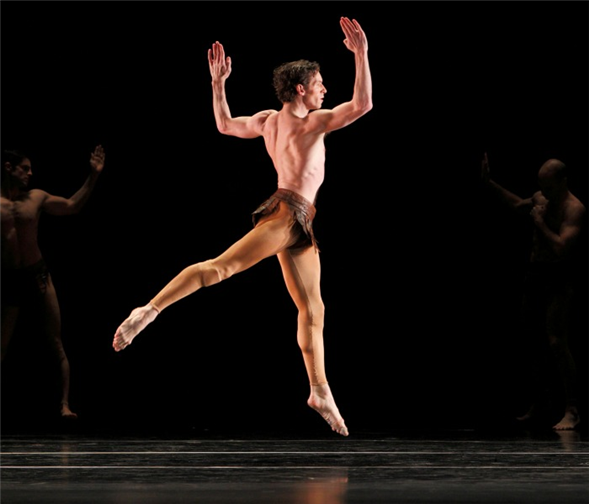Translate Page

The stalwart company presents three world premieres, two by outside choreographers
---
Paul Taylor American Modern Dance kicks off its annual three-week run at Lincoln Center with a diverse program that mixes company classics with exciting world premieres. In addition to presenting 14 enduring Taylor dances, the choreographer is debuting his 147th work, Concertiana, set to a violin concerto by Eric Ewazen, alongside commissioned pieces from Doug Varone and Bryan Arias.
Varone, a mainstay of the city's modern dance scene, has been creating work for his own eponymous company for 30 years, and frequently choreographs for opera, including several productions at the Met. In contrast, Arias is an up-and-comer with an increasingly busy freelance schedule -- he choreographed a work for Juilliard's December dance concert and has a new piece premiering at Gibney Dance Company in May. Yet despite being at very different points in their careers, both jumped at the opportunity to collaborate with Taylor's troupe.
"I was eager to work with these dancers, and I felt like I was going to learn something as well about my own dance-making," says Varone. "To work with dancers of this caliber is extraordinary, and I'm excited to have live music." (The Orchestra of St. Luke's plays at all performances this season.)
"I was quite nervous approaching these accomplished artists who have so much information in their bodies," admits Arias. "But all those nerves melted away as soon as I got into the studio because the dancers were so open and curious."
Varone's Half Life, for 12 dancers, was created in between his own troupe's tours, beginning with a getting-to-know-you period last June. "That was purely a play week, just to see where the meeting ground was between my process and aesthetic, and who they are as dancers," Varone says. "We played a lot of games to see where their creativity lay."
He returned in August -- by then he had chosen his score, Julia Wolfe's Fuel -- and again for stints in September, October, and December. "I prefer creating that way," Varone says. "I love going away from a work; that disappearance of consistency allows my brain to see what's really there. So often when you sit in a studio with a piece day after day, you can lose a sense of its trajectory."
Arias's The Beauty in Gray features the entire 18-member company. Like Varone, he used his initial time with the dancers to explore. "I always start the process with a period of improvisation -- observing the choices of the individuals in response to tasks," he explains. "It's my way of getting to know them and the choices they're comfortable making."
For 60 years after the company's founding in 1954, Paul Taylor dancers only performed pieces by their namesake. But in 2015, the octogenarian dance-maker decided to add works by outside choreographers to the repertoire. Understandably, there was an initial period of uneasiness. "Stylistically, the challenge was to get out of the frame of mind of being a Taylor dancer," says Michelle Fleet, who performs in both new works. "I think it's ingrained in our bodies and minds at this point. Being able to break away from that, and to take on the style of a new choreographer, is definitely a challenge, but satisfying at the same time, knowing that we are capable of being chameleons in that way."
Fellow company member Sean Mahoney concurs. "Learning all of these different works allowed me to see that I don't have to always do the ABCs of Taylor the exact same way," he says. "I can add a little of this or that, and make my style unique. So it's a great way to pull from those things and enhance what I'm doing in Taylor's repertory."
As a longtime fan of Taylor's work, Varone knew his markedly different style would push the dancers -- and thus his dance-making -- to new places. But that's been the beauty of opening up the company to new choreographers. "My sense of movement feels more transition-based, while there's a more static sensibility to the Taylor vocabulary," Varone says. "Someone once said that my work is very similar to blowing glass, whereas Paul's dancers and dancing is more about glass being etched."
Mahoney gives a more visceral metaphor. "At first it felt like shoving a boulder off the side of a mountain," he says. "Then we just had to roll with it."
To read about a student's experience at Paul Taylor, check out this post on TDF's sister site SEEN.
---
TDF MEMBERS: At press time, discount tickets were available for Paul Taylor American Modern Dance. Go here to browse our current offers.
Susan Reiter regularly covers dance for TDF Stages.
Sean Mahoney in Musical Offering. Photos by Paul B. Goode.